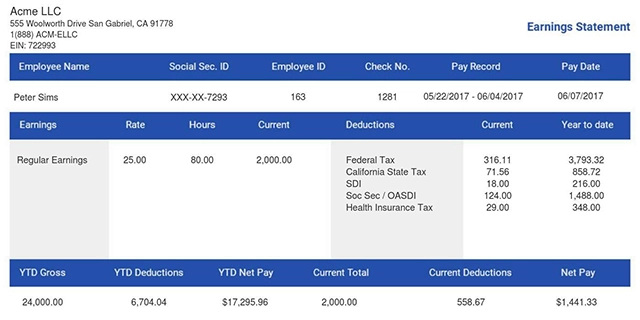Paycheck Deduction Codes: What Do They Really Mean?
A paycheck stub serves as a scannable record of your earnings for a pay period. One would think that such an important document would be easy to read. Yet many people get confused by the small codes and amounts on a pay stub.
These short codes are called paycheck deduction codes, and their job is to inform you on how your money works. They show you all the deductions applied to your gross earnings to give you your net pay.
In this guide, we will look into what these deduction codes really mean and how they affect what you are paid. You will learn how to read them and how to fix common deduction errors. We also explain how a check stub maker and payroll systems can do all the calculations for you.
- What Are Paycheck Deduction Codes?
- How To Verify Your Deductions on a Pay Stub
- Common Deduction Codes And What They Mean
- Deduction Codes for Social Security, Medicare, and FICA
- Deduction Codes for Federal Income Tax and State Taxes
- Deduction Codes for Benefits, Insurance, and Retirement
- What Are Pre-Tax Deductions and Post-Tax Deductions?
- Common Deduction Codes Mistakes and How To Fix Them
- To Sum It Up
What Are Paycheck Deduction Codes?
When you look at pay stubs, you will see some lines, each labeled with short codes. These lines represent different categories that all play a part in computing your net pay. A good percentage of these codes represent your deductions.
They show updated, detailed information like taxes, employee benefits, retirement, insurance, and others. The reason for using pay code abbreviations is to ensure the document fits neatly on a page. Before deduction codes are applied, make sure to verify all details on your pay stub.
Correct pay stubs should show:
-
Basic information like company name and address.
-
The pay period and pay date.
-
Hours worked and wages.
-
Gross earnings and deductions.
-
Year-to-date details for each code.
-
The final net pay.
Having correct pay stubs means you will have the accurate figures on all deductions applied. These help payroll teams, accountants, and organizations track payroll reporting. They also let you and your employer check what was deducted on a reliable system.
How To Verify Your Deductions on a Pay Stub
For correct, accurate deductions, you need to create reliable paystubs with all the right details. Always verify the details on your check stub to confirm that all deductions are accurate and present. Here is a simple step-by-step guide to verify the details on your paycheck stub.
-
Check the company and employee details. You should closely verify the employee's name and ID number to ensure only your deductions are applied to your earnings.
-
Next, verify that the pay period and pay dates are correct. These details are required when calculating your deductions and filing your taxes. Confirm that the required schedule information is right.
-
You should also scan through your hours and hourly rate if you are paid by the hour. Always verify the number of hours worked and any overtime.
-
Take note of the gross earnings for the period. This will be your total before deductions.
-
Review all the deduction codes individually and compare the amounts to your rate and deductions.
-
Review your year-to-date columns for your totals for the tax year.
-
Check your net pay and confirm that it aligns with the deductions applied.
If a code is unfamiliar, look at the pay stub abbreviations section on your company's payroll portal. If you still do not understand, ask payroll or HR to clarify these details. However, for the common ones used across the board, keep reading to learn what each one means.
Common Deduction Codes And What They Mean
Here are some of the common codes you may find on your stub and what they really mean:
| Code | Full Term | What It Means |
|---|---|---|
| FED or FIT | Federal Income Tax | Federal income tax withheld from the paycheck. |
| STATE or SIT | State Income Tax | State income tax withheld. |
| FICA or SS | Social Security | Social Security tax withheld. |
| MED | Medicare tax withheld. | |
| 401K or RET | 401(k) or Retirement plans | Employees' retirement contributions. |
| FSA or HSA | Flexible Spending Account or Health Savings Account | Pre-tax contributions for medical expenses, depending on the employer plan. |
| INS or MED INS | Insurance or Medical Insurance | Employees' premium contributions for health, dental, or vision. |
| GARN | Garnishment | Court-ordered deductions. |
| OT | Overtime | Extra payments for hours worked over the regular threshold. |
| BONUS | Bonus or Additional Earnings | One-time or performance-based extra payments. |
| NET PAY | Net Pay or Take-home payments | The final amount the employee receives after all deductions. |
These payroll codes are the same or similar across many companies. Some employers use custom pay codes for specific deductions that align with their system. If you see a new code you do not understand, reach out to HR for verification. Not sure what a code on your stub means? Create a stub using the 123 Paystub process to view the deduction codes and amounts.
Deduction Codes for Social Security, Medicare, and FICA

Medical and Social Security are two non-negotiables when it comes to deductions. They are a key part of the Federal Insurance Contributions Act. Aside from the codes for Social Security and Medicare, you may also see FICA or OASDI on your stub. Here are their codes and what they mean:
-
Social security is primarily listed as SS, FICA, or OASDI. Employers and employees each pay a share. For employees, that share is deducted from what they earned.
-
Medicare is usually listed as MED. Both employers and employees are responsible for Medicare payments.
These federal insurance contributions are mandatory for all organizations and small businesses. They are part of systems put in place to support retirement and medical programs. Employers and employees need it for audits, taxes, and claiming benefits.
Deduction Codes for Federal Income Tax and State Taxes
On your pay stub, federal income tax will appear as any of these three: FED, FIT, or FITW. It is largely determined by your payments and your W-4 choices.
On the other hand, your state taxes will show as a separate line. In some cases, it is fully spelled out, while in others it is abbreviated. For example, OH ST TX refers to Ohio state tax. State rules regarding tax codes vary depending on the state.
Deduction Codes for Benefits, Insurance, and Retirement
Your benefits also contribute to a large chunk of your deductions. They are typically handled through payroll, and you see the deductions on your stub in codes. Here are some of the common benefit deductions and what they mean:
-
Health insurance refers to MED INS, HEALTH, or INS on your stub
-
Dental could show in two ways. Either as DEN or DENT.
-
Retirement contributions are commonly listed as 401(K). It could also be RET. Your retirement contributions are pre-tax deductions.
-
Flexible spending account or health savings account. It is shown as the abbreviation FSA or HSA.
Employer-paid contributions may also show on your stub, and they represent what your employer paid for your benefits. These contributions are not taken out of your payments but are included for transparency.
What Are Pre-Tax Deductions and Post-Tax Deductions?
There are two different types of deductions that apply to what you have earned. On the one hand, we have the pre-tax deductions, and on the other hand, we have the post-tax deductions. Here is what each one represents:
-
Pre-tax deductions reduce taxable wages before taxes are calculated. They include your 401(k), health insurance plans, and flexible spending account contributions. These lower your immediate tax burden.
-
Post-tax deductions are taken after taxes.
You need to know the difference and how they apply to what you have earned. This helps you plan out your money.
Common Deduction Codes Mistakes and How To Fix Them
Both payroll teams and employees can make code errors. These errors may, in turn, affect take-home pay and taxes when reporting. Fixing them fast reduces audits, compliance issues, and workplace disputes.
The Wrong Code Applied to a Deduction
A deduction with the wrong code, for example, using a benefits code instead of a tax code. Pre-tax and post-tax misclassification is more common than most people think. Such a mistake would be costly on a payroll system, as it would be computed pre-tax instead of post-tax.
How to fix it: Review the stub to trace the misplaced code. Take note of the pay date and pay period and send all details to your payroll monitoring manager. You should get a corrected stub reissued. Keep the feedback and updated documents for record purposes.
Incorrect Tax Withholding Code
The federal or state tax code on the stub may not match payroll’s calculations or the employee's W-4 or W-4 equivalent. This error can cause unexpected tax bills or tax refunds. It can also affect filing and auditing reports.
How to fix it: You will need to verify the employee’s W-4 data and confirm the calculations. If payroll used outdated tables, ask them to rerun payroll with the current tables. If you changed your W-4 recently, confirm that payroll received and applied it.
Garnishment Code Issues
The garnishment code may be missing, or the wrong amount is applied. It could also be that the right deductions were applied to the wrong pay period. Since garnishments are legal orders, they must be applied correctly to avoid issues. Errors on garnishments can trigger litigation or legal penalties.
How to fix it: Ensure payroll has the correct and updated legal order. You should also request a written account of how payroll applied the garnishment. Always confirm details and ensure documentation for record purposes.
Duplicate Deduction Code Entries
This happens when the same deduction is applied multiple times under two codes. This will affect your net pay and disrupt your account calculations. Your year-to-date details would also be inflated.
How to fix it: Trace and find the duplicate code and where it was applied. Make a request for a correction to payroll with the necessary documentation. Then keep the corrected stub for record sake.
Custom or Unclear Internal Codes
Some employers and organizations use company-specific codes that many employees do not recognize. These codes may cause issues when filing and calculating net pay. Confusion on how deductions are applied can lead to disputes and missing requests for corrections.
How to fix it: Always verify all company-specific codes. If you see a code you do not recognize, confirm with HR what it means. You can also check your onboarding documents to see a breakdown of all company-specific codes.
Outdated Tax-Table or System Error
This is very common with payroll systems that use old tax tables. It could also be due to a software bug in payroll software. As a result, many employees get wrong withholding or deduction amounts.
How to fix it: Contact your payroll data management department immediately. Make sure you get an email that confirms the corrections.
To Sum It Up
Paycheck deduction codes are an integral part of your earnings. Both employers and employees need it for accurate and compliant payroll-related processes. Understanding these codes reduces the risk of payroll errors.
Using a secure pay stub generator helps to reduce human error when applying deduction codes on a stub. It is also a great option for small businesses and sole proprietors to ensure reliable and accurate pay stubs. To avoid deduction errors, use our stub creator to generate compliant stubs in minutes.















